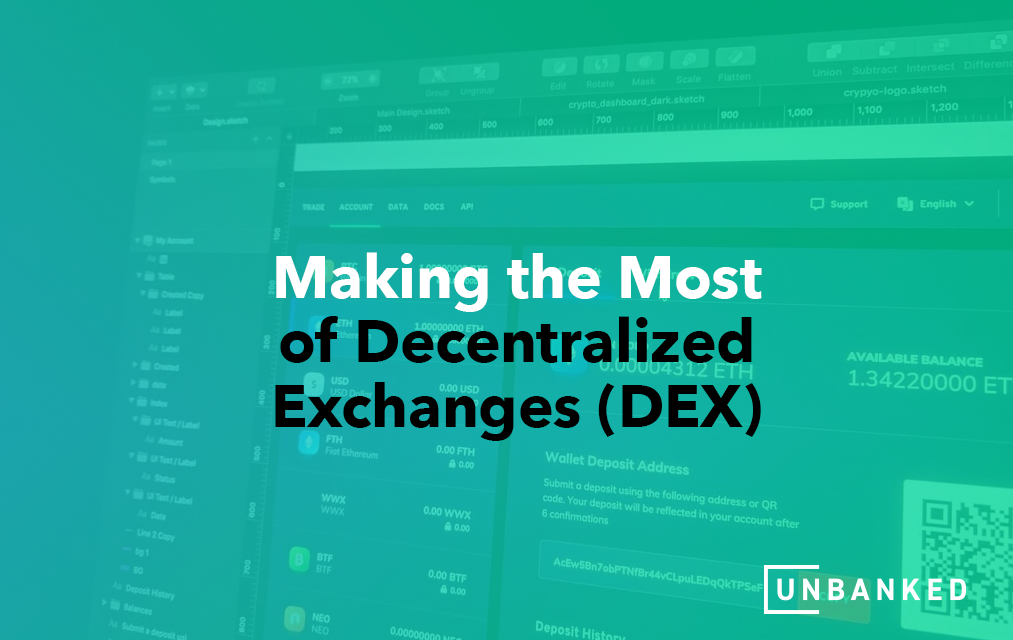Cryptocurrency has proven to be a strong alternative financial instrument that facilitates digital transactions and the possibility of trading using means. However, to successfully trade any form of cryptocurrency, you need to have a crypto exchange to start trading the digital currency. That is where decentralized exchanges (DEX) come into play.
A decentralized exchange enables peer-to-peer transactions without intermediary involvement, operating like stock markets so that cryptocurrency traders can make regular transactions directly. Additionally, decentralized exchanges leverage smart contracts, including any self-executing agreements facilitated by code. But, how can you make the most of the various layers that accompany a decentralized exchange?
Looking to learn more about the basics of Crypto? Check out our Crypto terms every investor should know.
What is a Decentralized Exchange (DEX)?
A decentralized exchange (DEX) is a peer-to-peer marketplace that gives participants the ability to trade cryptocurrencies without needing an intermediary to handle any transfers or holding of money.
Think of decentralized exchanges as a replacement for your traditional brokers, banks, payment processors, or other organizations that handle money. Smart contracts that come from blockchain ecosystems are what allow the exchange of assets between participants.
When a traditional financial transaction is done, they usually are not transparent and offer minimal insight into how the process is done. On the contrary, DEX is entirely transparent so that the participants can see the movement of money through the exchange.
The risk to other parties when trading cryptocurrency through DEX is also lowered because funds don’t need to pass through a third party’s cryptocurrency wallet.
Decentralized Exchanges are the root of decentralized finance (DeFi) and serve to allow more sophisticated financial products to take shape.
There have been specific innovations over the years that have solved many liquidity problems, such as automated market makers (AMM), which have contributed to the growth of the decentralized finance arena.
Wallet extensions and DEX aggregators have also driven the rise in decentralized platforms by creating better prices for tokens, slippage, swap fees, and better participant rates.
How Does the DEX Work?
As you dive into how the DEX works, you will find that various DEX designs offer scalability, multiple features, and decentralization. Not all are created equal, and participants must choose what works best for them. The two most common types are automated market makers (AMMs) and order book DEXs.
DEX aggregators are also used on DEXs to search for the best prices for the user’s desired transactions. The best part about DEXs is that they use blockchain technology and smart contracts that never change.
Suppose you compare decentralized exchanges to centralized exchanges (CEXs) such as Binance, which uses an internal matching engine for trades. In that case, the DEXs facilitate trading through on-chain transactions and smart contracts.
The best part is that decentralized exchanges let participants keep their funds using their own self-hosted wallets while trading.
When using the DEX, participants must pay network and trading fees. These network fees cover the cost of the on-chain transactions, and the trading fees are gathered by the liquidity providers, holders of tokens, or a mixture of these as designed by the protocol.
The main goal behind the decentralized exchange is an accessible, end-to-end chain infrastructure with decentralized ownership across a group of distributed stakeholders.
The community of stakeholders can vote on crucial protocol decisions.
The biggest challenge is keeping the decentralization of the protocol working at its maximum potential while keeping it competitive. With this challenge, many DEXs will choose to use a distributed governance structure to stop censorship from taking place and maintain their long-term resilience.
How To Use A Decentralized Exchange
Unlike many other programs, you don’t need to sign up for anything or even use an email address to participate in these types of platforms. This is simple as anyone with a smartphone can use this financial technology offered by DEXs.
Instead, participants need a wallet that works with the smart contracts on the exchange’s network.
The first step to using DEXs is to determine which network you want to use because each trade that you do will require you to pay a transaction fee.
Next, you must choose a wallet that works in conjunction with your selected network. The wallet will need to be funded with the native token of the specifically chosen network. You will use these tokens to pay your transaction fees.
The main benefit of wallet extensions is that you can access your funds anywhere and from any browser using decentralized applications (Dapps) such as DEXs. These apps are password protected but furthermore require users to create a new one or import an existing wallet through a private key.
It’s also convenient because many wallets have mobile apps associated with them so that traders can use DeFi protocols anywhere at any time. Participants can also sync wallets within a variety of devices.
As mentioned above, once you find a wallet, you will need to fund the wallet with the native token from the network. These tokens must be bought through centralized exchanges (CEXs) and can be identified by their ticker symbols, such as BTC for Bitcoin. Once you’ve bought your desired amount, you can easily withdraw them from your wallet.
How Does a Decentralized Exchange Benefit Crypto Traders?
How can crypto traders make more efficient deals through decentralized exchanges?
Decentralized exchanges have been operational since their introduction in 2014, becoming popular as decentralized financial services were increasingly built on blockchain technology while automated market maker (AMM) technology helped ease any liquidity issues the exchanges faced.
Decentralized exchanges were created to eliminate the need for supervision or authority on transaction authorization on the exchanges. The exchange supports peer-to-peer cryptocurrency trades by directly linking crypto buyers and sellers. Because they are not custodial types of exchanges, decentralized exchanges let users have full control and ownership over private keys, increasing their popularity within the cryptocurrency community.
There are three types of decentralized exchanges available to crypto traders.
Automated Market Makers
An automated market maker system, as mentioned earlier, uses smart contracts to eliminate any liquidity issues with the exchange. The system leverages blockchain services to retrieve information from exchanges to set the prices for any traded assets. The services are referred to as blockchain oracles, using the smart contracts to leverage liquidity pools, which are pre-funded asset pools. Smart contracts are a more seamless method than simply matching buying and selling orders.
To maximize AMMs, users must fund the liquidity pools before being rewarded with transaction fees based on trades allocated for the parties involved. Such users must deposit equivalent values of each asset included in a trading pair, to earn interest on crypto assets through liquidity mining. The pools in an AMM decentralized exchange lets traders earn interest in a trustless and permissionless way while also giving them the necessary control to execute orders.
Order Book DEXs
One of the earliest yet most effective forms of decentralized exchanges, order book DEXs keep records of every open order for an asset purchase and sale for specific asset pairs. Buy orders typically indicate a trader’s desire to bid for or purchase assets at a specific price while sell orders show the trader wants to move the asset on or ask for an exact price to sell it at some stage.
Order book DEXs include on and off-chain order books. The on-chain decentralized exchanges store all open order details on the chain, helping traders to leverage their respective positions by using lender funds on their platforms. Meanwhile, the off-chain decentralized exchanges store the order books from the blockchain network, only authorizing transaction settlements on the blockchain, providing the true value of centralized cryptocurrency exchanges. Additionally, off-chain order book DEXs can reduce transaction costs, though there are smart contract-related risks by doing so.
DEX Aggregators
Then, there are DEX aggregators, which have been emerging as a top addition within the crypto world. DEX aggregators are trading protocols that consistently source and route liquidity via multiple decentralized exchanges thanks to particular requirements. DEX aggregators include:
- Slingshot
- Matcha
- 1Inch
By using DEX aggregators, traders can optimize their crypto trading approaches at will.
DEX Innovation Makes It Easier to Use the Exchange
Decentralized exchange development has been steadily increasing in recent years with the Integral DEX, for example, showing how to properly blend order book models with AMM models for optimized DEX development. Hybrid decentralized exchanges, meanwhile, offer the possibility of freeing capital from depth, allowing the exchange for mirroring competitor order books on its smaller liquidity reserves. Because of this possibility, the exchange realizes the full value of concentrated liquidity which is also very efficient.
Additionally, there are various models of the AMM decentralized exchange like Proactive Market Making. The Proactive Market Making style allows the decentralized exchange to proactively modify parameters in real-time, such as price curves, to improve trading precision.
The Benefits and Risks of Using Decentralized Exchanges
Decentralized exchanges allow you to trade with any token
Decentralized exchanges are promising avenues for cryptocurrency trading because they prioritize availability, emphasize security, and preserve anonymity, among other benefits.
Benefits of Decentralized exchanges
Firstly, DEXs offer increased token availability for cryptocurrency traders. Decentralized exchanges provide access to cryptocurrencies that have been minted on the blockchain that they have been developed on. This ensures that new projects list their tokens on the decentralized exchanges before officially listing them on their centralized counterparts.
Another key benefit for crypto users is that decentralized exchanges assure users of no counterparty risks when engaging with them. Counterparty risk is usually apparent when one of the parties within a transaction doesn’t fulfill their duty. Given that users aren’t required to transfer their assets to an exchange using DEXs, they are less exposed to potential theft or a loss of funds due to cybercriminal activity. Because decentralized exchanges use smart contracts to facilitate trades, users won’t have to depend on any intermediary interventions during a transaction, preserving its validity. Plus, DEXs prevent price manipulation or any trading volume alterations.
New and obscure cryptocurrencies can be traded that were previously hard to move. And, DEXs are trustless, preserving user funds, personal data and privacy. There is no need to create an on-exchange account when using DEXs, nor is there any requirement to fill out a Know Your Customer (KYC) form, nor do any users need to provide user identification.
Also, users can make the most of decentralized exchanges as the exchanges do not control user funds at any juncture. Traders own their funds at all times and can interact with the exchanges based on their preferences. Users have full anonymity and can make transactions with other users as they like.
Want to know more about cryptocurrency trading and exchanges? Take a look at our resources to learn more about how crypto works.
Risks of Using DEXs
Understanding the advantages of using DEXs is important, but knowing the risks is even more crucial so you can see the entire picture.
Not Knowing Security-Related Concepts
If you are going to get involved with DEXs, you need to know about security-related concepts to keep your funds safe within the DEX crypto exchange. To add to this, you need to read up on wallets and make sure you are funding your wallet with the correct tokens depending on what exchange you choose.
“Rug Pull” Scam Risks
Like with any type of investing, there are scams within the DEXs that take place. Anyone can place a new token on the decentralized crypto exchange to liquidate their funds.
Yet this can turn into a scam where investors purchase a token with the thought that they are getting another token, and they end up getting nothing. The best way to avoid this is to verify the tokens you are buying before you invest in them.
Smart Contract Risks
Although smart contracts are extremely useful and have made the DEX what it is today, there are still risks associated with them. There are some bugs in these smart contracts that can be exploited and could get overlooked during the auditing process, as well as detailed code reviews which can lead to worse damage within the smart contracts.
Summary
Decentralized Exchanges have been a crucial platform for participants to borrow funds to offer liquidity in order to pay for trading fees.
DEXs have made it possible to earn passive income on crypto holdings by putting them into pools designed for liquidity.
If you are looking for more information on cryptocurrency exchanges, please contact Unbanked today.





